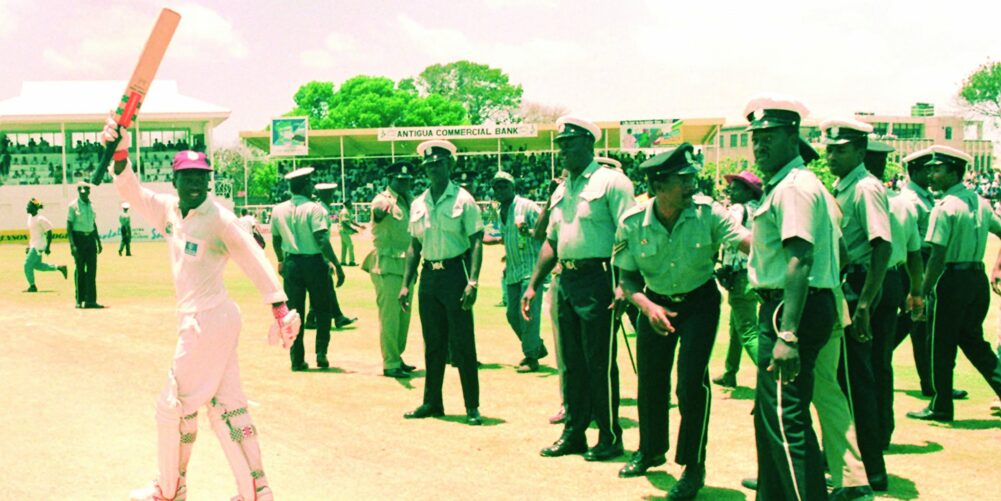It was enough to make Sir Vivian Richards weep and that hasn’t happened very often.
When I bumped into the Masterblaster in the facilities behind the Press box at the stadium named after him shortly after the second Test of the 2009 series between England and West Indies had been abandoned with just ten balls bowled, it seemed appropriate to offer my condolences.
But there was no need to ask him what he thought of the embarrassing farce that we had just witnessed, of bowlers sinking into the sand as they ploughed through over-prepared run-ups.
He might also have been shedding a tear for all those other sights, sounds and places that had, until that point, made the Antiguan cricket experience unique for players and spectators alike.
Many of them lived at the ramshackle collection of stands and sheds known as the Rec, the ground where Viv grew into the leading batsman of his generation and on which, against England in April 1986 he made the then fastest Test century of all-time, from 56 balls.
The West Indies cricket authorities had jumped at the chance take the $60m of Chinese money to build the new ground in time for the 2007 World Cup, part of their benefactors’ policy of “stadium diplomacy”, and duly abandoned the ground next to the prison on the edge of St John’s for a concrete monstrosity in North Sound, never mind that the half-hour trip from the capital made it inaccessible to the locals for whom the old place was merely a stroll away.
To be fair to the West Indies Board, the old ground would probably not have been able to cope with what ICC now demanded of venues for their global tournaments.
It was cramped and bits were falling off it, after all.
But it had always been home and cricket on the island and in the region has just not been the same since they left it.

In the stand that nuzzled up to the old pavilion, there was Chickie, bursting the eardrums of the spectators surrounded by the loudest outdoor disco on the planet. There was his mate Gravy bumping and grinding and conducting the locals in their joyful winding up of the visitors.
And there was the third of the happy trinity, Mayfield in his latest and most outrageous outfit.
I can’t exactly remember which of them it was who once walked to the middle at the fall of another England wicket, but I can still see the oversized enormous motorcycle crash helmet he was wearing and a thick cable-knit sweater to keep him warm in 85-degree heat.
And most clearly of all I recall the giant bat he was carrying, as long as the stumps and at least three feet wide, indicating he felt this was the only chance Graham Gooch’s batsmen had of surviving against Ian Bishop, Curtly Ambrose, Courtney Walsh and Eldine Baptiste.
He was right. West indies clinched a previously tightly contested series with victory by an innings, the after-match party featuring a similarly one-sided match between a couple of members of Her Majesty’s Press and the brother of Richie Richardson, who closed down the snack bar he ran on the pavilion roof for the purpose, using a splintered plank of fence wood for a bat and, for balls, his uneaten cheese rolls wrapped in cling-film.
There, four years later, was Brian Lara reaching his first world record Test score of 375, the final Test against England being halted for 20 minutes while Sir Garfield Sobers, whose record the Trinidadian genius had just broken, strode out to congratulate him.
And there, about 50 yards round the outfield from the Press box, were a couple hoisting onto the outfield a metal trolley and urn from which to serve portions of corn soup during the unscheduled interval.
They were nowhere to be seen by the time Lara repeated the feat in 2004, making 400 against Michael Vaughan’s team, though one suspects the fun police wouldn’t have let them get anywhere near this time.
Now, on February 13, 2009, the second Test to be staged at the Sir Vivian Richards Ground was over amid widespread hand wringing, head shaking and tears from the mighty. Following the intervention of ECB chairman Giles Clarke pointing to the thousands of England supporters who’d made the trip to see some cricket, a second match was hastily arranged for, and played at The Rec.
It was and, in all probability will be, the last Test every staged there.
Thankfully, in the moment of greatest sadness there was one moment of black comedy to lighten the mood.
An hour or so after the end of the match the fire alarm in the Press box sprang into life. As is the norm in these cases it was studiously ignored but, after ten minutes of this racket and with no member of stadium staff in evidence, it was decided something should be done.
Following a brief search, the control panel was located and the lower protective cover removed so that instructions to turn it off could be read and carried out.
And the plan might have worked had it not been for the fact that the instructions were written in Chinese.
PETER HAYTER / Photo: Getty Images















